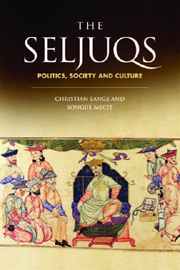Book contents
- Frontmatter
- Contents
- List of figures
- Acknowledgements
- List of abbreviations
- INTRODUCTION
- PART I POLITICS
- 1 THE ORIGINS OF THE SELJUQS
- 2 ASPECTS OF THE COURT OF THE GREAT SELJUQS
- 3 ‘SOVEREIGN AND PIOUS’: THE RELIGIOUS LIFE OF THE GREAT SELJUQ SULTANS
- 4 KINGSHIP AND IDEOLOGY UNDER THE RUM SELJUQS
- 5 SELJUQ LEGITIMACY IN ISLAMIC HISTORY
- PART II SOCIETY
- Part III CULTURE
- Index
1 - THE ORIGINS OF THE SELJUQS
from PART I - POLITICS
Published online by Cambridge University Press: 12 September 2012
- Frontmatter
- Contents
- List of figures
- Acknowledgements
- List of abbreviations
- INTRODUCTION
- PART I POLITICS
- 1 THE ORIGINS OF THE SELJUQS
- 2 ASPECTS OF THE COURT OF THE GREAT SELJUQS
- 3 ‘SOVEREIGN AND PIOUS’: THE RELIGIOUS LIFE OF THE GREAT SELJUQ SULTANS
- 4 KINGSHIP AND IDEOLOGY UNDER THE RUM SELJUQS
- 5 SELJUQ LEGITIMACY IN ISLAMIC HISTORY
- PART II SOCIETY
- Part III CULTURE
- Index
Summary
The farthest back that we can trace Seljuq origins is to the Turkish tribe of the Oghuz, but beyond the opening years of the 10th century we are in the realm of conjecture and inference. In the later 6th century, Byzantine envoys visited the Qaghans of the Western Türkü, the T'u-chüeh of the Chinese annals, Ishtemi and his son Tardu, in their summer pasture lands in the Tien Shan mountains, with the aim of concerting an alliance against the common enemy, Sasanid Persia, but the accounts of the Byzantine historians regrettably give us no information about the component units of the Qaghans' confederation. In fact, the Oghuz do not appear specifically as the Ouzoi in Byzantine sources such as Constantine Porphyrogenitus and others until the 10th century.
The actual name Oghuz corresponds to that of the Oghur in Western Turkic of the LIR variety (this being opposed to the more widespread and betterattested ŠAZ variety, what Golden calls ‘Common Turkic’), now known to us only from fragments of the Turkic language of the Bulghars on the middle Volga in early Islamic times and from modern Chuvash, whose speakers are located to the west of the confluence of the Volga and Kama rivers. The Oghur mentioned in Byzantine Greek sources, like the historian Priscus, as *Ogouroi and *Onogouroi go back to events of the 5th century and information on the Hunnic invasions of Europe from Inner Asia at that time. These tribal groups (with whom the Sarogour, perhaps ‘White Oghur’, are mentioned) sent embassies to the Emperors in Constantinople and were probably part of the Western Türkü/T'u-chüeh confederation.
- Type
- Chapter
- Information
- The SeljuqsPolitics, Society and Culture, pp. 13 - 21Publisher: Edinburgh University PressPrint publication year: 2011



